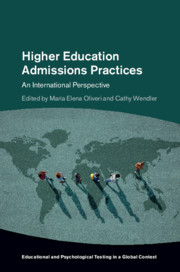Book contents
- Higher Education Admissions Practices
- Educational and Psychological Testing in a Global Context
- Higher Education Admissions Practices
- Copyright page
- Contents
- Figures
- Tables
- Contributors
- Series Editor’s Foreword
- Foreword
- Acknowledgments
- Part I Global Challenges and Common Admissions Models
- Part II Country-Specific Admissions Practices
- Chapter 7 Admissions Policies and Practices and the Reshaping of Access Patterns to Higher Education in Africa
- Chapter 8 Chile’s Admissions Tests: Pending Changes and Revisions
- Chapter 9 Issues of Perceived Fairness in Admissions Assessments in Small Countries: The Case of the Republic of Cyprus
- Chapter 10 Higher Education Admissions Practices in Israel
- Chapter 11 Access, Equity, and Admissions in South African Higher Education
- Chapter 12 Admissions Practices in Sweden
- Chapter 13 Revisions of Admissions Testing in Vietnam: From Elite to Mass Higher Education
- Part III Assessments Used in Higher Education Admissions
- Part IV Rethinking Higher Education Admissions
- Index
- References
Chapter 8 - Chile’s Admissions Tests: Pending Changes and Revisions
from Part II - Country-Specific Admissions Practices
Published online by Cambridge University Press: 09 January 2020
- Higher Education Admissions Practices
- Educational and Psychological Testing in a Global Context
- Higher Education Admissions Practices
- Copyright page
- Contents
- Figures
- Tables
- Contributors
- Series Editor’s Foreword
- Foreword
- Acknowledgments
- Part I Global Challenges and Common Admissions Models
- Part II Country-Specific Admissions Practices
- Chapter 7 Admissions Policies and Practices and the Reshaping of Access Patterns to Higher Education in Africa
- Chapter 8 Chile’s Admissions Tests: Pending Changes and Revisions
- Chapter 9 Issues of Perceived Fairness in Admissions Assessments in Small Countries: The Case of the Republic of Cyprus
- Chapter 10 Higher Education Admissions Practices in Israel
- Chapter 11 Access, Equity, and Admissions in South African Higher Education
- Chapter 12 Admissions Practices in Sweden
- Chapter 13 Revisions of Admissions Testing in Vietnam: From Elite to Mass Higher Education
- Part III Assessments Used in Higher Education Admissions
- Part IV Rethinking Higher Education Admissions
- Index
- References
Summary
Chile’s national, centralized admissions system selects students for both public and private universities that are part of the Unified Admission System. This chapter details the centralized admissions process that controls, supervises, and evaluates the tests; how the testing operation –testing, scoring, application, and selection processes – is conducted; equity issues in admission to Chilean higher education institution; and reforms to the admissions test, the Prueba de Selección Universitaria.
- Type
- Chapter
- Information
- Higher Education Admissions PracticesAn International Perspective, pp. 145 - 160Publisher: Cambridge University PressPrint publication year: 2020
References
- 4
- Cited by



